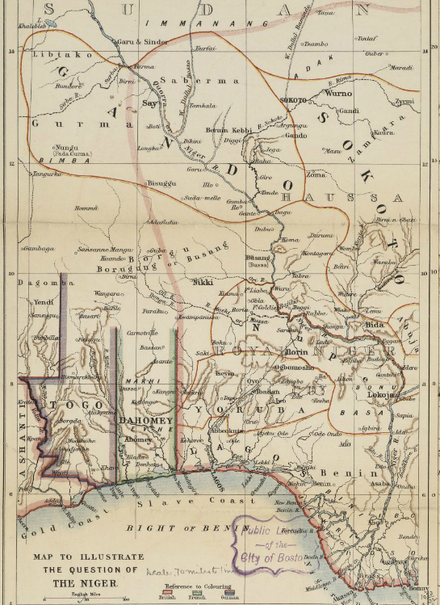Map of Yoruba people, West Africa (Nigeria), 1898
The Yoruba eventually established a federation of city-states under the political ascendancy of the city state of Oyo, located on the Northern fringes of Yorubaland in the savanna plains between the forests of present Southwest Nigeria and the Niger River.
Following a Jihad led by Uthman Dan Fodio and a rapid consolidation of the Hausa city states of contemporary northern Nigeria, the Fulani Sokoto Caliphate invaded and annexed the buffer Nupe Kingdom. It then began to advance southwards into Ọyọ lands. Shortly afterwards, its armies overran the Yoruba military capital of Ilorin, and then sacked and destroyed Ọyọ-Ile, the royal seat of the Ọyọ Empire.
Following this, Ọyọ-Ile was abandoned, and the Ọyọ retreated south to the present city of Oyo (formerly known as "Ago d'oyo", or "Oyo Atiba") in a forested region where the cavalry of the Sokoto Caliphate was less effective. Further attempts by the Sokoto Caliphate to expand southwards were checked by the Yoruba who had rallied in defense under the military leadership of the ascendant Ibadan clan, which rose from the old Oyo Empire, and of the Ijebu city-states.
However, the Oyo hegemony had been dealt a mortal blow. The other Yoruba city-states broke free of Oyo dominance, and subsequently became embroiled in a series of internecine conflicts that soon metamorphosed into a full scale civil war. These events weakened the southern Yorubas considerably as the Nigerian government pursued harsh methods to bring an end to the civil war. In 1960, greater Yorubaland was subsumed into the Federal Republic of Nigeria.[7] The historical records of the Yoruba, which became more accessible in the nineteenth century with the more permanent arrival of the Europeans, tell of heavy Jihad raids by the mounted Fulani warriors of the north as well as of endemic intercity warfare amongst the Yoruba themselves. Archaeological evidence of the greatness of their ancient civilization in the form of, amongst other things, impressive architectural achievements like Sungbo's Eredo that are centuries old, nevertheless abound.[8]
Map of Yoruba people, West Africa (Nigeria), 1898
The Yoruba eventually established a federation of city-states under the political ascendancy of the city state of Oyo, located on the Northern fringes of Yorubaland in the savanna plains between the forests of present Southwest Nigeria and the Niger River.
Following a Jihad led by Uthman Dan Fodio and a rapid consolidation of the Hausa city states of contemporary northern Nigeria, the Fulani Sokoto Caliphate invaded and annexed the buffer Nupe Kingdom. It then began to advance southwards into Ọyọ lands. Shortly afterwards, its armies overran the Yoruba military capital of Ilorin, and then sacked and destroyed Ọyọ-Ile, the royal seat of the Ọyọ Empire.
Following this, Ọyọ-Ile was abandoned, and the Ọyọ retreated south to the present city of Oyo (formerly known as "Ago d'oyo", or "Oyo Atiba") in a forested region where the cavalry of the Sokoto Caliphate was less effective. Further attempts by the Sokoto Caliphate to expand southwards were checked by the Yoruba who had rallied in defense under the military leadership of the ascendant Ibadan clan, which rose from the old Oyo Empire, and of the Ijebu city-states.
However, the Oyo hegemony had been dealt a mortal blow. The other Yoruba city-states broke free of Oyo dominance, and subsequently became embroiled in a series of internecine conflicts that soon metamorphosed into a full scale civil war. These events weakened the southern Yorubas considerably as the Nigerian government pursued harsh methods to bring an end to the civil war. In 1960, greater Yorubaland was subsumed into the Federal Republic of Nigeria.[7] The historical records of the Yoruba, which became more accessible in the nineteenth century with the more permanent arrival of the Europeans, tell of heavy Jihad raids by the mounted Fulani warriors of the north as well as of endemic intercity warfare amongst the Yoruba themselves. Archaeological evidence of the greatness of their ancient civilization in the form of, amongst other things, impressive architectural achievements like Sungbo's Eredo that are centuries old, nevertheless abound.[8]
🌎✍️




